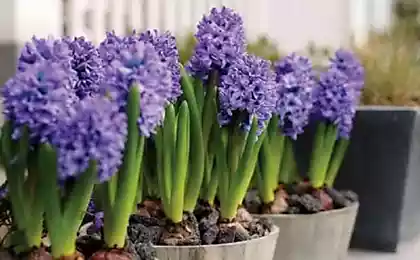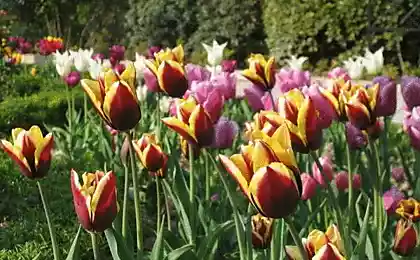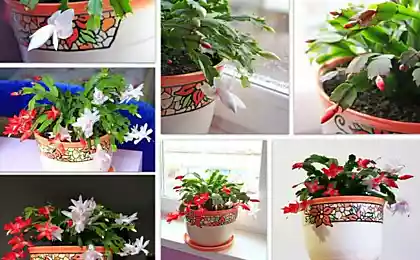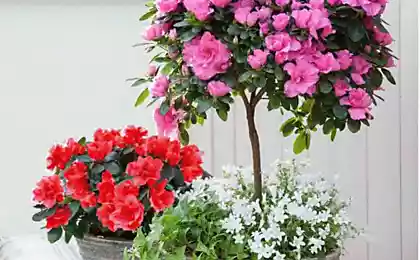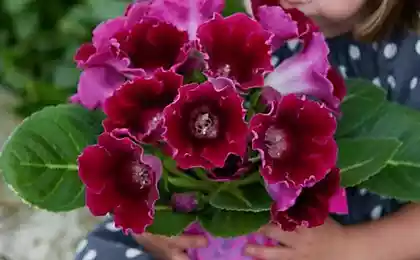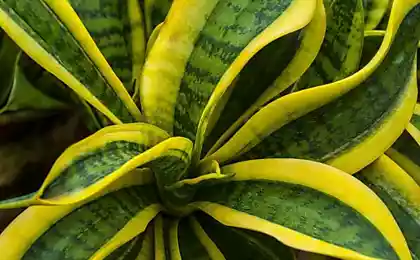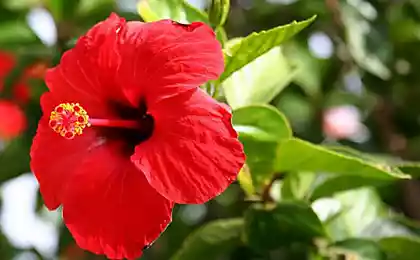576
How to care for potted campanulas
Campanula, as it is called, a bell – one of the most popular and hardy indoor plants. The birthplace of this flower — Italy.
Campanula have blooms from spring to autumn. Campanula is a low grassy basket plant with thin creeping or hanging shoots which are small rounded leaves with scalloped edge.
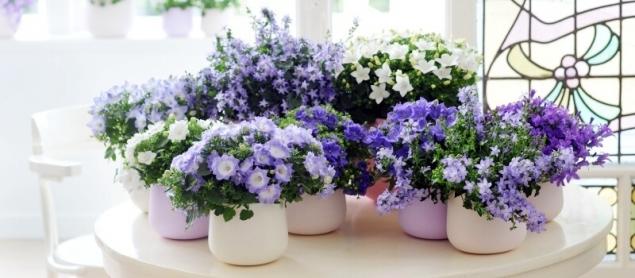
Among the green leaves stand out bright white or blue flowers. In people, plants with blue flowers are called "suitors", and white "brides".
To obtain a lush, flower-strewn Bush, you can't lift that shoots up, they should go down.
Currently derived forms with double flowers.
Blooms Campanula long (June to September) and very abundant.
There are hybrids with two tone colors-gears.
In the flowering period, usually in summer, the plant is fully covered with scatterings of white, mauve or blue flowers-stars, this cascade of flowers Campanula called "Falling stars". Flowers clustered at the ends of shoots, blossoms and a lot of them at once for abundant and prolonged flowering you should promptly remove faded.
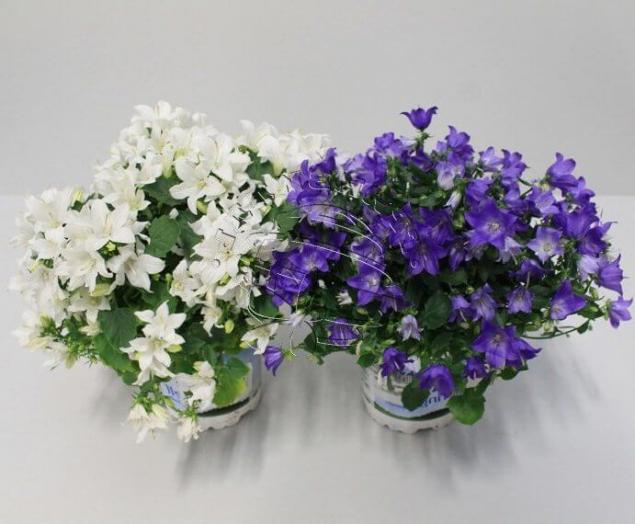
Bell "the bride and Groom" are not demanding to care for, grows quickly, blooms profusely. In the summer it is possible to grow outdoors in light shade.
Lighting. Bright but diffused light, shading from direct sun on the South window. Best suited in Eastern or Western window. Since January, when the day begins to lengthen, the meager winter sun Campanula enough to bloom.
If there is too little light, shoots elongated, the distance between the sheets increases, the decorative effect is lost.
Watering and humidity. Abundant watering in spring and summer during the period of growth and flowering, the soil should be vlazhnovatoy. Autumn reduce watering in winter, watering is very rare.
Campanula afraid of the stagnant water in the pot and the pan, which leads to siltation of the soil. In this case, the root system of the flower is affected rot in just a few days, which leads to his inevitable death. For this reason, after each watering the soil in the pot should loosen, allowing access of air to the horses, and the excess moisture from the pan immediately to drain.
It is better to water in the morning to the next watering soil ball time to dry. It is advisable to use slightly warmed water.
Campanula are not picky about the humidity of the air does not require special humidification and is easily adaptable to any conditions.
Temperature. Moderate, more than 22 degrees is not desirable. In the winter, cool content, about 12-14°C. in summer to grow outdoors in light shade.
Care after flowering. As soon as the flowering period comes to an end, the plant needs to create the conditions for a good rest. The upper part of the shoots are usually, by this time have time to dry, so they can be cut. From the lower parts subsequently will develop new flower buds, so their touch is desirable.
As a rule,the shoots are pruned in late winter or spring, leaving 2-3 dormant buds. When they grow up to 10-12 cm, gently pinched the growth point, then the side branches will start to grow accordingly be more flowers.
A period of rest. With the onset of the short autumn days growth Campanula stops, but the plant does not completely die. The need for watering is also reduced. It is desirable to trim the long stems and move the plant to a cool room. Watering should be rare (1-2 times per month). The winter temperature of 10-15 degrees.

Fertilizer. From March to August during the period of growth of new shoots and flowering feed fertilizer for indoor decorative flowering plants, every 2-3 weeks.
Transplant. It is possible to transplant in the spring, but as the plant is not a long period of life, but you can just plant in the early spring of the new cuttings.
Soil. In natural conditions it grows on rocky ground, special requirements to the nutritional value of the soil does not show, but the roots need to breathe. The soil is better to use loose. You can use a mixture of turf, leaf, humus, peat earth and sand.
With the onset of spring have crop dried shoots and gradually increase watering.
The period of the life of the plant is small, in a year or two the plant needs to be upgraded.
Reproduction Campanula
Propagated by seeds and by cuttings in the spring.
Campanula seeds are very small, they can be sown in early spring. Watering is not necessary, only spray.
In early spring, when young shoots reach lengths of 10-20 cm, carefully cut them off "with promenade," and immediately put them in water or planted in soil mixture (a mixture of sand with peat). Pour solution fitosporin and put in teplichku.
The optimum temperature for rooting is 12-13°C. to Provide daily ventilation. After three weeks start slowly to lift the hot-house and a week later you can put the rooted chertochki on the window sill, where the cuttings start to grow quickly. Watering they don't need regular spraying. But excessive moisture can cause rot.
When the plants grow to 10-12 cm, can be gently pinched the growth point, then begin to grow lateral branches and Bush will be more branched and lush, and flowering is more abundant.
Home flower can be propagated by dividing the Bush. If the plant has grown strong in the spring, carefully take the flower from the pot and carefully divide the plant into pieces, while trying to preserve the roots of the earth com. You can just cut the soil ball with a sharp knife. Do not divide the plant into too small pieces, when transplanting the plant try not to bury.
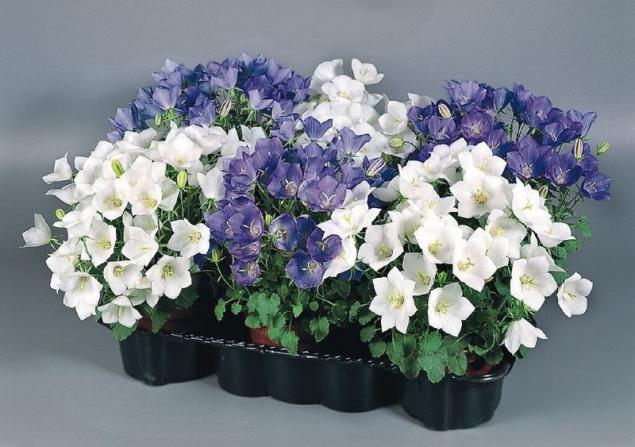
If you want to put in a pot of plants with white and blue flowers, will need a partition in earthen coma. Otherwise more active "the bride" survives "the bridegroom."
Diseases and pests. The greatest damage is caused by scale insects and spider mites. Too high humidity can cause the appearance of Botrytis.published
P. S. And remember, only by changing their consumption — together we change the world! ©
Source: vk.com/public47900340?w=wall-47900340_283448
Campanula have blooms from spring to autumn. Campanula is a low grassy basket plant with thin creeping or hanging shoots which are small rounded leaves with scalloped edge.

Among the green leaves stand out bright white or blue flowers. In people, plants with blue flowers are called "suitors", and white "brides".
To obtain a lush, flower-strewn Bush, you can't lift that shoots up, they should go down.
Currently derived forms with double flowers.
Blooms Campanula long (June to September) and very abundant.
There are hybrids with two tone colors-gears.
In the flowering period, usually in summer, the plant is fully covered with scatterings of white, mauve or blue flowers-stars, this cascade of flowers Campanula called "Falling stars". Flowers clustered at the ends of shoots, blossoms and a lot of them at once for abundant and prolonged flowering you should promptly remove faded.

Bell "the bride and Groom" are not demanding to care for, grows quickly, blooms profusely. In the summer it is possible to grow outdoors in light shade.
Lighting. Bright but diffused light, shading from direct sun on the South window. Best suited in Eastern or Western window. Since January, when the day begins to lengthen, the meager winter sun Campanula enough to bloom.
If there is too little light, shoots elongated, the distance between the sheets increases, the decorative effect is lost.
Watering and humidity. Abundant watering in spring and summer during the period of growth and flowering, the soil should be vlazhnovatoy. Autumn reduce watering in winter, watering is very rare.
Campanula afraid of the stagnant water in the pot and the pan, which leads to siltation of the soil. In this case, the root system of the flower is affected rot in just a few days, which leads to his inevitable death. For this reason, after each watering the soil in the pot should loosen, allowing access of air to the horses, and the excess moisture from the pan immediately to drain.
It is better to water in the morning to the next watering soil ball time to dry. It is advisable to use slightly warmed water.
Campanula are not picky about the humidity of the air does not require special humidification and is easily adaptable to any conditions.
Temperature. Moderate, more than 22 degrees is not desirable. In the winter, cool content, about 12-14°C. in summer to grow outdoors in light shade.
Care after flowering. As soon as the flowering period comes to an end, the plant needs to create the conditions for a good rest. The upper part of the shoots are usually, by this time have time to dry, so they can be cut. From the lower parts subsequently will develop new flower buds, so their touch is desirable.
As a rule,the shoots are pruned in late winter or spring, leaving 2-3 dormant buds. When they grow up to 10-12 cm, gently pinched the growth point, then the side branches will start to grow accordingly be more flowers.
A period of rest. With the onset of the short autumn days growth Campanula stops, but the plant does not completely die. The need for watering is also reduced. It is desirable to trim the long stems and move the plant to a cool room. Watering should be rare (1-2 times per month). The winter temperature of 10-15 degrees.

Fertilizer. From March to August during the period of growth of new shoots and flowering feed fertilizer for indoor decorative flowering plants, every 2-3 weeks.
Transplant. It is possible to transplant in the spring, but as the plant is not a long period of life, but you can just plant in the early spring of the new cuttings.
Soil. In natural conditions it grows on rocky ground, special requirements to the nutritional value of the soil does not show, but the roots need to breathe. The soil is better to use loose. You can use a mixture of turf, leaf, humus, peat earth and sand.
With the onset of spring have crop dried shoots and gradually increase watering.
The period of the life of the plant is small, in a year or two the plant needs to be upgraded.
Reproduction Campanula
Propagated by seeds and by cuttings in the spring.
Campanula seeds are very small, they can be sown in early spring. Watering is not necessary, only spray.
In early spring, when young shoots reach lengths of 10-20 cm, carefully cut them off "with promenade," and immediately put them in water or planted in soil mixture (a mixture of sand with peat). Pour solution fitosporin and put in teplichku.
The optimum temperature for rooting is 12-13°C. to Provide daily ventilation. After three weeks start slowly to lift the hot-house and a week later you can put the rooted chertochki on the window sill, where the cuttings start to grow quickly. Watering they don't need regular spraying. But excessive moisture can cause rot.
When the plants grow to 10-12 cm, can be gently pinched the growth point, then begin to grow lateral branches and Bush will be more branched and lush, and flowering is more abundant.
Home flower can be propagated by dividing the Bush. If the plant has grown strong in the spring, carefully take the flower from the pot and carefully divide the plant into pieces, while trying to preserve the roots of the earth com. You can just cut the soil ball with a sharp knife. Do not divide the plant into too small pieces, when transplanting the plant try not to bury.

If you want to put in a pot of plants with white and blue flowers, will need a partition in earthen coma. Otherwise more active "the bride" survives "the bridegroom."
Diseases and pests. The greatest damage is caused by scale insects and spider mites. Too high humidity can cause the appearance of Botrytis.published
P. S. And remember, only by changing their consumption — together we change the world! ©
Source: vk.com/public47900340?w=wall-47900340_283448

